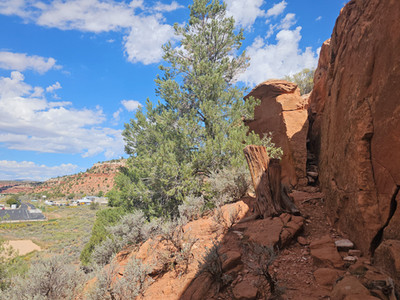Hand-to-Hand with the Past: Hiking to the Kanab Dinosaur Tracks
- Dan Wagner
- Sep 30
- 2 min read
The Kanab Dinosaur Tracksite hike is a short but interesting walk into deep time, where a gentle trail leads across slickrock to a sandstone slab stamped with fossilized dinosaur tracks. Just minutes from town yet set against wide desert views, the path blends the simplicity of a casual stroll with the wonder of standing in the footsteps of creatures that roamed the earth nearly 200 million years ago.


Trailhead elevation 5,085'
Water none
Don't miss the fastest way up through the crevice
Hiking the Kanab Dinosaur Tracks Trail
It’s our third day in Kanab, and after an early stroll out to the Sand Caves Trail, I decide to swing by the dinosaur tracks—a site I’ve visited more than once before. Since it’s only a couple miles south and right along my route to our cabin, it makes for a perfect detour. I pull into the small, unmarked gravel lot at 37.083487, -112.538963 (Google Maps will take you to the wrong spot) and set off right away.

The tracks sit on top of the formation directly beside the lot, and while the hike is short, it helps to know where you’re going. From the parking area, I take a faint, unsigned trail to the right, skirting past a more obvious path that runs parallel to the rocks.

Just a few hundred feet in, I veer left and climb steeply toward the cliffs—experience tells me that if I’d stayed on the road-side trail, I’d be wandering around for half an hour.

Soon I reach a flat ledge and slip through a narrow crevice in the cliffs.
Beyond it, the path forks left and right, but from past visits I know the most direct route is straight up. After twenty feet, I spot a trail marker and continue higher, stopping midway to catch my breath and take in the view of the tiny parking area below.

At the top, the tracks spread out across the sandstone, each one outlined with small circles of stone.

Most are three-toed prints left by theropods—two-legged, meat-eating dinosaurs that would have ranged from human-sized to much larger. A few suggest ornithopods, smaller plant-eaters that also walked on two legs. The fossils date back about 180 million years, when this land was part of a vast desert of dunes and shallow watering holes. Dinosaurs crossed damp sand, their steps hardened, and time preserved them until erosion uncovered the story again.

Someone has poured water into one the more obvious prints to make it stand out—a common trick for photos but unfortunately one that speeds up erosion. A reminder of how fragile these traces of the past really are.

I launch my drone to get a few overhead shots, spotting the old route I once took years ago from a paved lot below. From up here, it’s obvious why so many people never manage to find the tracks.

On my way down, I retrace my steps. Now that I know the way, it’s only a five-to-seven minute walk, though I remember the first time I came here it took me nearly an hour to puzzle out the trail splits. Today, it’s a quick revisit—an ancient chapter of prehistory resting just outside of downtown Kanab.
_edited.png)









































